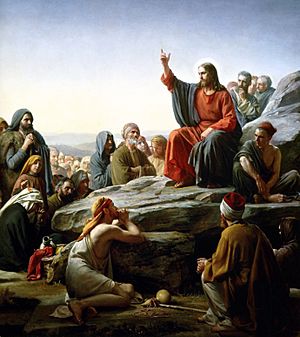Lord's Prayer facts for kids
The Lord's Prayer is the most famous prayer in the Christian religion. People also call it the Our Father because those are its first two words. In Latin, it is known as Pater noster, which also means "Our Father." This prayer has been called the Lord's Prayer since the Protestant Reformation.
You can find this prayer in two places in the New Testament part of the Bible. It appears in the books of Matthew (chapter 6, verses 9-13) and Luke (chapter 11, verses 1-4). Jesus taught his disciples this prayer when they asked him how they should pray. It was an example of how to talk to God.
The Bible has been translated into English many times. Because of this, there are a few different versions of the Lord's Prayer. One of the oldest and most well-known English versions comes from the Book of Common Prayer in 1662:
- Our Father, which art in heaven,
- hallowed be thy name;
- thy kingdom come;
- thy will be done,
- in earth as it is in heaven.
- Give us this day our daily bread.
- And forgive us our trespasses,
- as we forgive them that trespass against us.
- And lead us not into temptation,
- but deliver us from evil.
- For thine is the kingdom,
- the power, and the glory,
- For ever and ever.
- Amen.
Music and the Lord's Prayer
Many famous composers have created music for the Lord's Prayer. They have set the words to beautiful melodies. Some of these composers include Luigi Cherubini, Martin Luther, Charles Gounod, Franz Liszt, Igor Stravinsky, and Pyotr Ilyich Tchaikovsky.
Even in modern times, artists continue to make new versions. For example, the group Söhne Mannheims made a modern musical version in 2004.
Images for kids
-
The Lord's Prayer (Le Pater Noster), a painting by James Tissot. This artwork is at the Brooklyn Museum.
-
A piece of the Lord's Prayer from the Lindisfarne Gospels. It shows the Latin text translated into an old English dialect.
-
The Lord's Prayer written in Syriac.
-
Three versions of the Lord's Prayer: (1) from Codex Zographensis in Glagolitic script (1100s); (2) from Codex Assemanius in Glagolitic script (1000s); (3) from Gospels of Tsar Ivan Alexander in Bulgarian Cyrillic script (1355).
-
The Lord's Prayer written in Greek.
See also
 In Spanish: Padrenuestro para niños
In Spanish: Padrenuestro para niños












